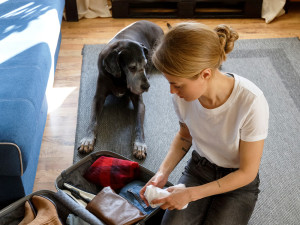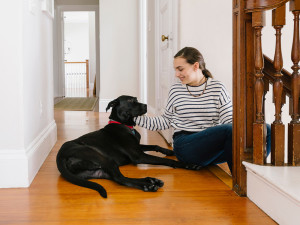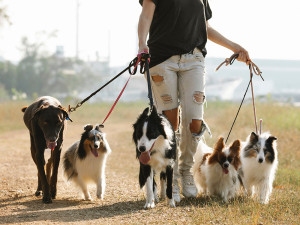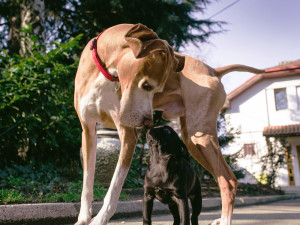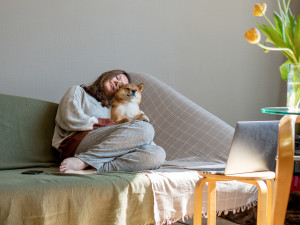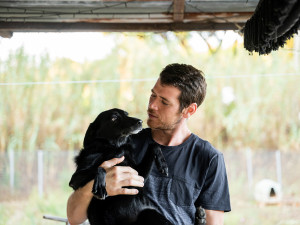Should You Send Your Pup to Dog Daycare?
Doggy daycare is more than just fun and games.
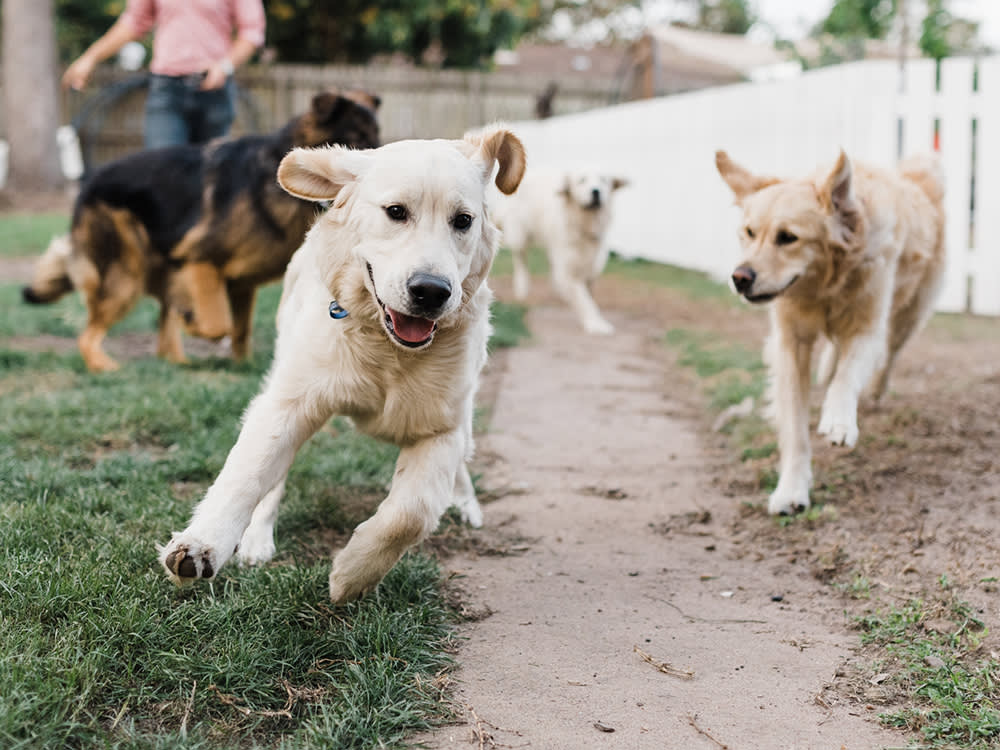
Share Article
There’s one universal stumper of a question that all pet parents face as they gear up for fewer summer vacations and more time at the office: “What do we do with the dog?”
There’s never an easy answer — especially if your dog can’t easily tag along to work with you — and it’s equally anxiety inducing to think of leaving them with a stranger. This might be, however, an anxiety that can be quelled by professionals who spend all day loving on dogs just like yours.
Across the U.S., dog-daycare businesses — franchises and single-owner operations alike — are flourishing. They offer your dog what you sometimes cannot: playmates, companionship, and supervision when other commitments take you away from home. Most keep hours similar to those of daycare centers for children: drop your dog off before work, pick them up afterward.
Do dog daycares provide a necessary service for both pet parents and their dogs? Are all daycares created equal? Is dog daycare an option you should consider? The answer is a resounding “it depends.”
Dog Daycare Benefits
Marc Bekoff, PhD, a University of Colorado ethologist who has studied dogs and their wild relatives for more than four decades, gives the concept of dog daycare a thumbs-up: “I love the idea. I think they provide a great function. At the same time, daycare should not replace people spending a good deal of time with their dogs.” E’Lise Christensen, DVM, a board-certified veterinary behaviorist in New York City, agrees: “For healthy, active, social dogs, daycare can be a great outlet for getting exercise and social enrichment.”
In fact, this belief is exactly what originally spurred the development of the dog daycare industry. “In the early 1990s, training professionals found there was a need for dogs to get out of the house, socialize and engage in mental stimulation and physical exercise,” explains Melinda Miller, hospital director at Smith Ridge Veterinary Center in South Salem, N.Y.
Social play and mental stimulation are the main reasons many people choose to enroll their dogs in daycare. Pet parents might want to send their dogs to a place to burn off energy, be social and run around without worrying about them being bored and alone. The complex process of domestication did not shape dogs for a solitary living (raise your hand if one is napping at your feet as you read this). On the other hand, dogs did not evolve to engage in all-day play sessions either.

Do Dogs Like Going to Daycare?
Dog daycare websites feature buzz words like “play,” “fun,” and “canine friends,” words that, for pet parents, readily elicit images of their dog exuberantly sparring with a new best friend. But what do social experiences at dog daycares look like?
In the daycare setting, dyadic play (play between two dogs) is probably the most prevalent type. A recent studyopens in new tab investigating social play in adult, group-housed dogs at a boarding kennel found that of 343 social-play bouts, all but one were dyadic in nature.
“This is not surprising,” notes Alexandra Horowitz, PhD, a professor of psychology at Barnard College, who has studied dog play behavior extensively. “Dyadic play is an easier dynamic for most dogs than triadic or larger-group play. In a bigger group of players, it would be hard to have play signals in all those different directions, and a dog could certainly miss something. Because of the complexity of play, this high-paced, rambunctious activity needs a lot of coordination.”
The idea of giving dogs space to play might seem straightforward enough, but there’s more to it than simply providing square feet. Numerous factors can influence the presence or absence of happy frolicking. While a dog’s physical size warrants consideration when forming daycare playgroups, play style is paramount.
Becky Trisko, PhD, behaviorist and owner of Unleashed in Evanston, Ill., knows this well. “A good daycare surveys play styles and groups dogs accordingly. At the same time, [it] also allows flexibility between groups throughout the day to manage personalities and excitement levels.”
Balancing Dog Play Styles
When it comes to play, turning up the dial is not always better. As Miller explains, “Hyper dogs allowed to get into a frenzy and maintain that level of excitement all day can be worse in the home than they were before they went to daycare. Staff members who help dogs learn about relaxed play and recognize when dogs need a time out or a change of pace and rest are helping both dog and pet parent.” Trisko agrees. “Pet parents often assume that an exhausted dog is a happy dog. But an exhausted dog could also be an irritated dog.”
In a well-run daycare, these issues are addressed by handlers who ensure that dogs engage in the congenial play their people envision. While no formal research has been done to validate these numbers, the consensus is that an ideal handler-to-dog ratio is 1:10, or 1:15 at the outside (Christensen recommends a ratio of 1:5).
If groups grow in size, so too should the level of human attention. But even with multiple human hands on deck, large dog groups can be challenging to manage. Kate Senisi, a former daycare employee, knows this firsthand. “Daycares that create multiple, smaller groups within a space, as opposed to one large group, allow for more direct supervision of the dogs. But that also means that the daycare has to provide additional staff to cover the new groups,” she says.
Done right, supervision gives dogs the variety they need within a complex environment. Though many daycares tend to highlight “all-day play,” a quick review of online daycare videos reveals dogs engaged in any number of activities. Some dogs play, some watch; others investigate something on the floor, jump on a handler, sit on a handler’s lap or lie on the floor. In other words, individual dogs have a range of interests that shift moment by moment, and good supervision can facilitate this variety.
According to Horowitz, it’s important that dogs have options and control. “Not to say that the dog is dictating the day, but that the dog has options to be social, to be with a person or by themselves. That would be the highest-quality day: a lot of things to do and being able to make choices about when and with whom to do it.”
Handlers perform a critical role in promoting fun and safety. Much like playground monitors, they pick up on individual behavioral cues — for example, noticing when a dog becomes anxious or has simply been playing for three hours straight and could use a change of pace. Fun can quickly disappear when a dog finds themself in an environment that conflicts with their emotional state.
The often-overlooked aspect of dog daycare is, of course, learning. “An important factor to consider,” says Laura Monaco Torelli, director of training at Animal Behavior Training Concepts in Chicago, “is that dogs are always learning, even in the daycare environment.”
Just as a toddler might return from preschool with their first painting of a flower and a bit of an attitude, so too might a dog return from daycare all tuckered out, and a bit jumpier and mouthier than when they went in.
Are All Doggy Daycares the Same?
At the end of the day, dog daycares are unregulated businesses. While daycare owners, managers and employees probably become involved in this particular enterprise because they love dogs and are interested in promoting canine welfare, it is an industry with no agreed-upon set of “best practices.” Some might have learned the business from authorities in the dog training and care world; for others, a random instructional website might suffice.
Staff Matters
Just as a love of children does not necessarily make someone a competent first-grade teacher, a love of dogs doesn’t automatically equip a person to manage the behaviors and personalities of a group of them.
“Is a daycare just looking for warm bodies who like dogs and can stay there for eight hours a day?” asks Miller.
Christensen adds: “Is the staff trained [in] the basics of dog behavior as based on science, not popular wisdom?”
Staffers’ ability to recognize stress and discomfort is just as important as their understanding of the complex set of movements that make up play. Play and aggressive displays share many elements, and even to a watchful, astute eye, meanings can change quickly.
Some daycares highlight their facilities’ bells and whistles: climate control, dog cams, unique flooring, or even a particular type of background music. Unfortunately, many daycare websites are silent on the less flashy ethological and organizational considerations that are most relevant to those concerned about their dogs’ welfare. For example, daycares rarely describe daily play and rest schedules, handling techniques, procedures for introducing new dogs to the group, criteria that determine how dogs are grouped, handler-to-dog ratios, access to outdoor space, and staff first-aid training.
There are many ways to handle the daily influx of bouncing dogs, and at their best, daycares do this by viewing every dog as an individual. Some daycares rely on message boards to keep track of the different canine personalities gracing their establishments. Descriptors might read: “Don’t let anyone jump on Tiger’s back. Keep Bella from being overstimulated. Keep Buddy from eating rocks or poop.”
But how do daycares uncover these nuances?
Prioritizing Behavior Assessments
A behavior assessment is the first step toward getting to know each dog’s unique needs. Even if a dog has been comfortable in comparable settings, there’s no foolproof way to predict how they will feel in a new environment. Each daycare provides a unique mix of sights, smells, sounds, movements and management styles, and any dog could be less- than-thrilled with their surroundings. Even dogs described by their pet parents as “social butterflies” or “happy players” do not necessarily thrive in every setting.
Assessments can also identify dogs who are not likely to be thrilled about daycare from the get-go. For some, discomfort with other dogs could spark aggression; others might be unable to de-stress in a group setting. With this information, daycares can evaluate whether they have the staff know-how and facility design to admit such dogs.
The behavior assessment is just the beginning of the story. John Squires, owner and manager of Wag Club in Brooklyn, N.Y., stresses that the daycare facility has an ongoing role in habituating each dog to its setting and rewarding good behavior. He has found that, unfortunately, not all daycares prioritize such methods. Some accept dogs who are not a good fit for a daycare environment without taking steps to help them acclimate, which could lead to a dog spending most of their time in a kennel rather than interacting with others.
Is Doggy Daycare for Your Dog?
The answer lies mainly with the individual dog. Some daycares are better than others at maximizing fun and safety and decreasing fear and stress. At the same time, dog daycare is not the only game in town. Your dog might prefer a long walk, a training class, a trip to the dog park, an open window where they can take in the passing sights and sounds, or a small playgroup. Consider what’s important to and appropriate for your dog. Also, consider how you might be able to build time for these extras into your schedule.
When thinking about our dogs’ quality of life, most of us inevitably ask the question, “What should my dog be doing all day while I’m gone?” If you think the answer for your dog involves daycare, then the next question is, “Which one?” A little due diligence on your part will result in a solution that’s right for your pup.
Tips for Finding the Best Dog Day Care
If you think your dog is being “interviewed” for daycare, think again. While their behavior is assessed and their vaccination record is examined, your job is to be the real interviewer. When checking out daycare operations, get answers to the following questions.
How is the facility set up?
Take a tour. Is it clean? Does it have multiple spaces for groups of dogs with different play styles? Do dogs have access to an outside area for bathroom breaks? Does the facility have a designated area for rest? If the daycare uses kennels, check them out and ask if and how stress is minimized during kenneling.
What kind of schedule does it provide?
All-day play is not a selling point. Dog daycares that incorporate bathroom breaks (ideally, outdoors), playtime, and quiet time into their schedules are what you’re looking for. Rest is important, and it is handled differently by each daycare. Find out how a daycare provides a restful space for its canine visitors.
How big are the playgroups?
The handler-to-dog ratio should be 1:10 (preferable), 1:15 tops. After all, 1:10 equals two human eyes and legs monitoring 10 noses, 20 eyes and 40 legs. On top of that, handlers often need to deal with other things in the environment — refereeing a play session that’s gotten a little over the top or cleaning up an accidental “deposit” — so having more than one person on duty is a plus.
What kind of training do the handlers have?
Daycare owners or managers might have Certification Council of Professional Dog Trainers (CPDT) credentials or be animal-behavior-conference junkies, but top-level staff are not customarily involved in daily dog supervision. Make sure the hands-on staff members are trained in canine communication and dog handling. Ask handlers about their training experience (or lack thereof).
How are new dogs introduced?
Gradual introductions set dogs up for success. Avoid a daycare that proclaims, “We throw them all in together for a fun playtime!”
Do they take all comers?
Accepting all dogs is not necessarily a good thing; remember, not all dogs are cut out for daycare. Whether a dog is too aggressive or too shy, some dogs will simply do better with a walk or home care.
What about toys?
Does the daycare provide toys? If so, which ones, and how does it prevent or monitor resource-guarding? While your dog might not exhibit this particular behavior, daycares should have procedures to address this potential issue and avoid needless confrontations between dogs.
Is medical help available?
Ideally, the daycare has a relationship with a veterinarian and staff members who are trained in CPR and first aid. In even the best-monitored situations, accidents can happen, and a quick response can be a literal lifesaver.
All of these questions — and thorough research — will likely give you the answer that’s right for you. And if daycare is the right choice, your pup is going to be thankful for treats and all that extra attention.

Julie Hecht, MSc
Julie Hecht, MSc, is a Ph.D candidate studying animal behavior at the Graduate Center, CUNY, and author of the Dog Spies blog at Scientific American. Her academic publications are featured in Applied Animal Behaviour Science and Animal Behavior for Shelter Veterinarians and Staff. She would really like to meet your dog and thinks that her cat, Josh, excels at being himself. And she loves him for it.
Related articles
![Woman holding her dog beside a window in bright morning light]()
Pet Parents Get Separation Anxiety, Too
We asked both animal behaviorists and human psychologists how you can deal with leaving your dog home alone.
![A woman packing her suitcase with a dog laying nearby.]()
How to Find the Dog Sitter Your Dog Deserves
Nobody loves your dog like you love your dog. But wouldn’t it be great if your dog sitter was a close second?
![shiba inu snuggling on couch with woman]()
Money Talks: The Dollars of Dog Parenthood
We crunched some numbers and yup, they’re worth every penny.
![A man holding a dog with an unsure look on its face.]()
“Why Does My Dog Bark at Men?”
What to do when your dog barks at the men in your life.
